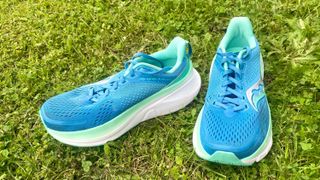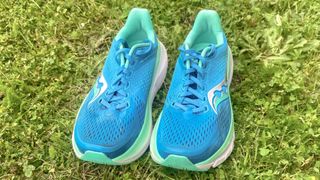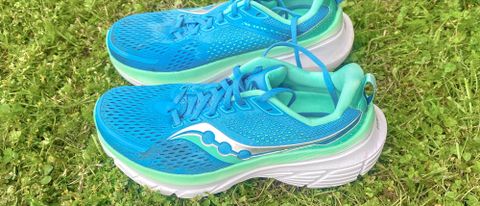Tom's Guide Verdict
This might not be the most versatile running shoe on the market but the Guide 17 is a great addition to Saucony's popular stability line. The wider platform, higher sidewalls and asymmetric design provide greater stability for your feet and perform well under easy and long run conditions.
Pros
- +
Wide and supportive platform
- +
Stable ride
- +
Roomy toe box
Cons
- -
Foam isn't overly responsive
- -
Not overly versatile
Why you can trust Tom's Guide
I started testing the Saucony Guide 17 — the brand's latest stability shoe — near the end of my marathon training and clocked over 50 miles wearing the shoe across a mixture of easy runs, long runs and some speedwork.
Compared to the Guide 16, there's a broader platform to stabilize your landings, and high sidewalls to cradle your feet so that you're firmly on the cushioning. On paper, it sounds like it could sit comfortably among the best running shoes.
But as I ran in the Guide 17, I began to see them as more of a recovery shoe for easy miles than for clocking up your new personal best. That doesn't mean they're bad shoes, but they didn't offer the kind of all-round performance I was expecting.
Saucony Guide 17: price and availability
The Saucony Guide 17, launched in February 2024, is priced at $140 in the US and £135 in the UK. If you considered the Saucony Ride 17, but needed more of a stability shoe, then the Guide 17 is one to consider as it's Saucony's stability version and costs the same.
Saucony Guide 17: design and fit

The Saucony Guide 17 is available in both men's and women's sizes, both offering regular and wide options. I have been testing a women's size regular 6.5 in the and found this fits true to size.
This size of the Guide 17 weighs 8.6oz, which ain't bad considering the shoes wide platform and the fact it has a stack height of 35mm in the heel and 29mm in the forefront.
There are plenty of colorways to choose from, no matter how subtle or bright you like your running kicks to be. The women's colors include: Black Fog, Breeze Mint (this is the color I tested), Cloud Cayenne, Dusk Canary, Iris, Navy Orchid, White Fern and White Jade.
Meanwhile, the men's shoes offer the following colors: Black Shadow, Denim Cloud, Dusk Canary, Flint Shadow, Navy Cobalt, Pepper Canary, Viziblue Peel and White Navy.
Upper
My fellow runners told me that the Guide 17 has more room in the upper compared to the older Guide 16. From the miles I've clocked in the Guide 17, I can vouch for that and say that I had enough wiggle room in the toe box to avoid any cramps but not too much that I found my feet sliding around inside the shoe.
The shoe features a gusseted tongue that sits alongside extra eyelets so you can adjust and tie down your feet to your liking. I found the upper to feel very comfortable and flexible on my runs, even during longer runs where I'm more likely to feel pressure points on top of my foot.
Although I wasn't testing this shoe in any crazy temperatures I did put the shoe through its paces on an 18-mile run and appreciated the breathability in the Guide 17.
Midsole

As part of Saucony's Center Path Technology included in the Guide 17, the design of the shoe features features a wide-based midsole that cradles your foot deeper within the shoe and is surrounded by higher sidewalls of foam.
For me personally, I sometimes find Saucony trainers dig into my heels and cause some discomfort but this wasn't something I felt wearing the Guide 17. The shoe also features a rocker effect and I liked how I rolled into my strides wearing this shoe, creating a smooth and efficient forward motion during my runs.
To look at, the shoe looks very cushioned which I didn't find felt this way in my first few easy runs and rather found the midsole to feel quite dense and rigid. However, after a few runs, I found the midsole foam broke in and became more flexible and comfortable.
The level of cushioning is ideal for easy and recovery runs but I wouldn't write home about the responsiveness of this shoe during my speedier runs.
Outsole

Part of the reason being for the Saucony Guide 17's lightness, is its minimal coverage on the shoe's outsole.
It features rubber around the back section of the shoe and some around the outer area of the forefoot of the shoe but overall there is a lot of exposed foam on the base. I did find things to feel a little less grippy while running on wet surfaces and wonder how solid the durability of the outsole will be longer term.
Saucony Guide 17: running performance
From breaking in the Guide 17 on my first few easy runs to testing them during tempo and interval sessions, and finally on an 18-mile run, I got to know where the Saucony Guide 17 excels and where it falls short.
The cushioning in this shoe isn't crazily responsive so it's not going to be of huge assistance in any speedier runs. But, this isn't what Saucony set out to do with the Guide 17. It's a stability shoe that felt light, supportive and comfortable while clocking my recovery and longer training runs and is now a staple shoe for my daily miles.
I found the width of the shoe provided great stability and the rocker meant I could roll nicely into my miles. The toe box was nice and roomy so I didn't experience any discomfort or cramping in my toes while running and I also felt safely secured in the shoe thanks to the lowkey yet supportive tongue and lacing system.
Should you buy the Saucony Guide 17?

If you're looking for a cushioned stability trainer to wear on your easy and long runs, then the Saucony Guide 17 is one to have on your radar. However, if you're looking to feel a bit more of a pop in your runs and feel some real response then you should check out Saucony's Ride 17 running shoe.
The Saucony Guide 17 will also make a great shoe for beginner runners. If it's your first time buying a proper pair of running shoes, you should also check out the Brooks Ghost 15 or the Nike Pegasus 40.

Jessica is an experienced fitness writer with a passion for running. Her love for keeping fit and fueling her body with healthy and enjoyable food quite naturally led her to write about all things fitness and health-related. If she isn’t out testing the latest fitness products such as the latest running shoe or yoga mat for reviewing then she can be found writing news and features on the best ways to build strength, active aging, female health, and anything in between. Before then she had a small stint writing in local news, has also written for Runners World UK (print and digital), and gained experience with global content marketing agency, Cedar Communications.
Born and raised in Scotland, Jessica is a massive fan of exercising and keeping active outdoors. When at home she can be found running by the sea, swimming in it, or up a mountain. This continued as she studied and trained to become a PPA-accredited magazine journalist in Wales. And since working and living in London, she splits her time between weight training in the gym, trying new fitness classes, and finding scenic running routes. Jessica enjoys documenting this on her fitness-inspired Instagram page @jessrunshere where she loves engaging with like-minded fitness junkies.
She is a big fan of healthy cooking and loves learning more about this area with expert nutritionists she has met over the years. Jessica is a big advocate for building healthy relationships with food rather than building restrictive attitudes towards it. When she isn’t eating or running she also enjoys practicing yoga in her free time as it helps her to unwind and benefits her performance in other sports.
